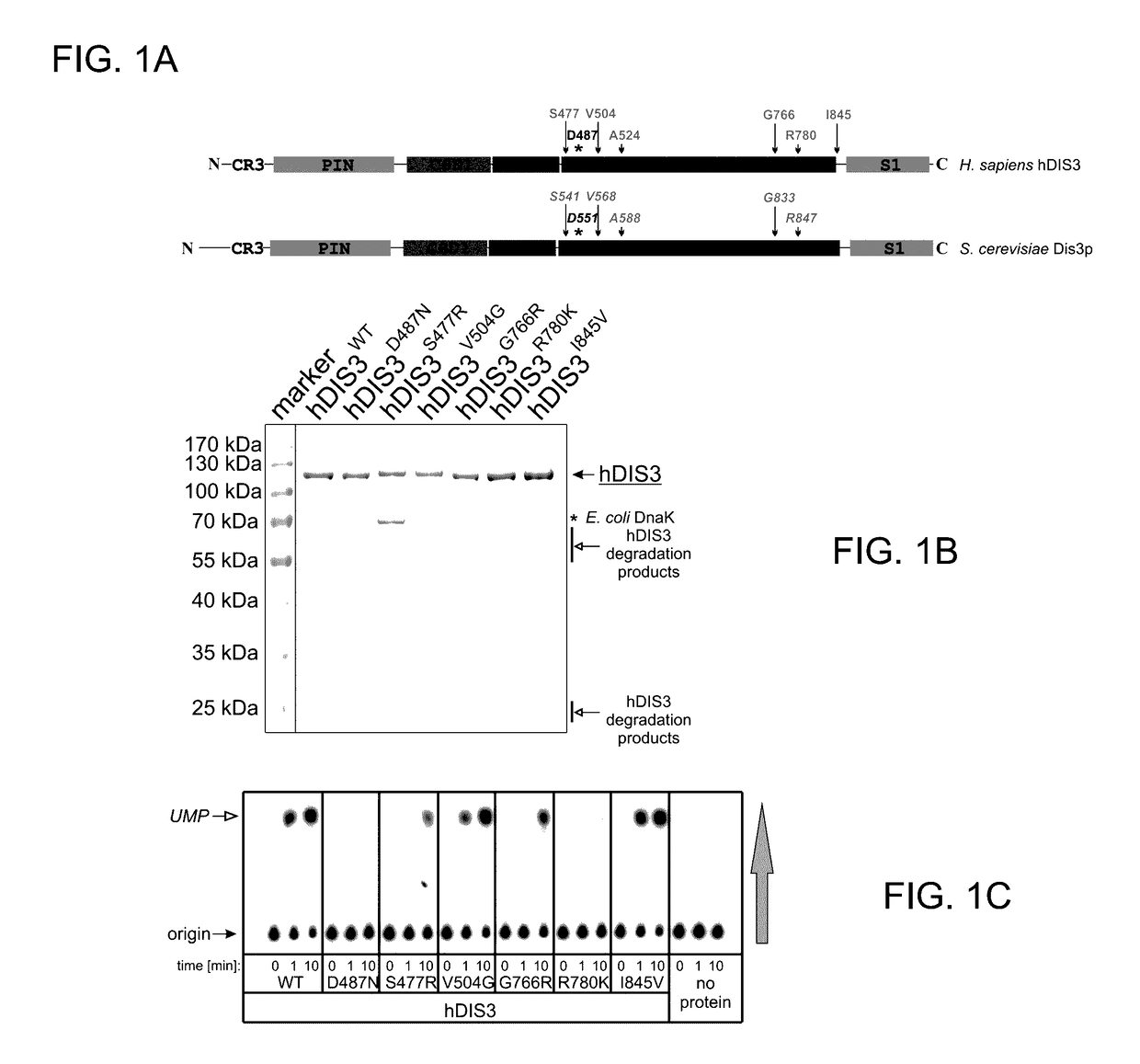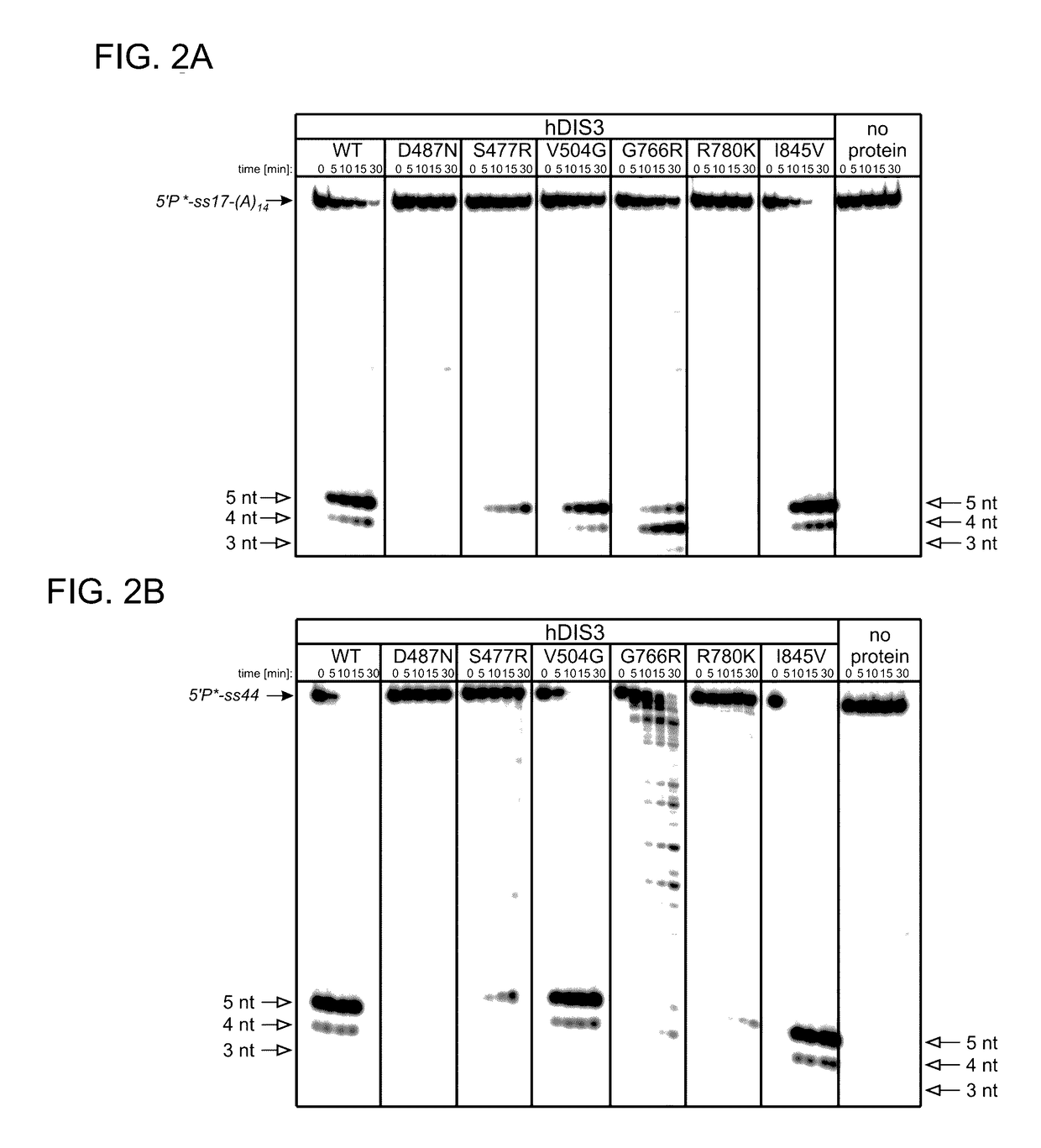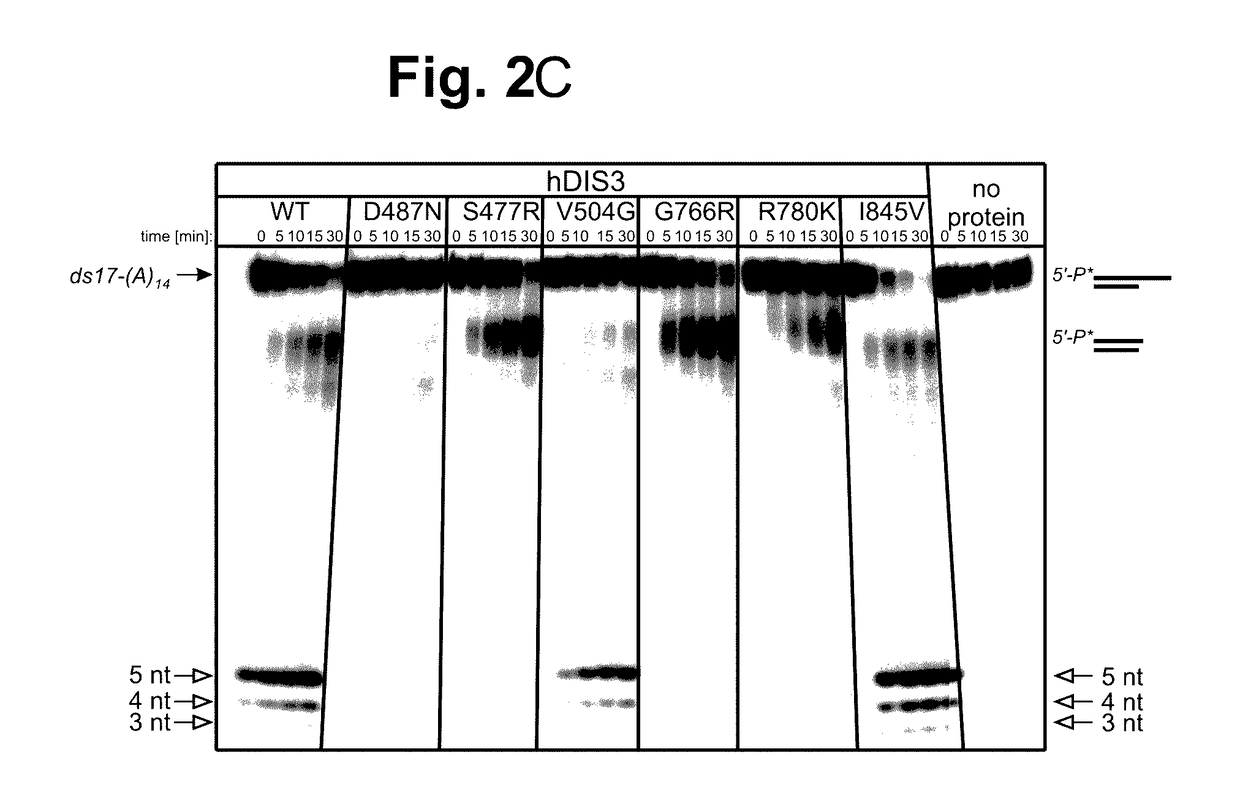Method for selection of hDIS3 PIN domain inhibitors and use of hDIS3 PIN domain inhibitors for cancer treatment
a cancer treatment and hdis3 pin technology, applied in the field of cancer treatment, can solve the problems of no successful treatment, difficult treatment, and cancer cells harboring such mutations may be potentially more vulnerable to further impairment of the exosome complex activity
- Summary
- Abstract
- Description
- Claims
- Application Information
AI Technical Summary
Benefits of technology
Problems solved by technology
Method used
Image
Examples
examples
[0142]In the following examples, unless specified otherwise, standard materials and methods are used as described in Sambrook J. et al. “Molecular Cloning: A Laboratory Manual, 2nd edition, 1989, Cold Spring Harbor, N.Y. Cold Spring Harbor Laboratory Press, or proceeding in accordance with manufacturers' recommendations for specific materials and methods.
Bacterial Strains
[0143]The following E. coli strains were used: MH1 (E. coli araD lacX74 galU hsdR hsdM rpsL), dam- / dcm-(New England Biolabs; E. coli ara-14 leuB6fhuA31 lacY1 tsx78 glnV44 galK2 galT22 mcrA dcm-6 hisG4 rfbD1 R(zgb210::Tn10) TetS endA1 rspL136 (StrR) dam13::Tn9 (CamR) xylA-5 mtl-1 thi-1 mcrB1 hsdR2), BL21-CodonPlus-RIL (Stratagene; E. coli B F− ompT hsdS(rB− mB−) dcm+ Tetr gal endA Hte [argU ileY leuW Camr]).
Yeast Strains
[0144]S. cerevisiae strain encoding fusion of wild-type Dis3p with and protein A tag-TEV protease cleavage site and TRP selection marker (ADZY532; referred herein to as wt) was a derivative of haploid...
example i
Proteins Encoded by some hDIS3 Gene Versions with MM-Associated Mutations Display Various Defects in the Degradation of Different RNA Substrates.
Oligonucleotides, Plasmids and Cloning.
[0149]The E. coli BL21-CodonPlus-RIL strain was used. Plasmids pMM1, pMM2, pMM3, pMM4, pMM5 and pMM6 (for heterologous expression of various hDIS3 versions in E. coli) were generated by site-directed mutagenesis with oligonucleotide pairs shown in Table 1, using a pHEX1 construct (encoding wild-type hDIS3; Tomecki et al. 2010b) as template.
[0150]
TABLE 1Primers used for site-directed mutagenesis and construction of recombinant hDIS3variants bearing MM-associated mutations, for heterologous expression in E. coli.Seq.Id.ConstructedhDIS3NameNucleotide sequence (5′-3′)NoplasmidvariantS477RforTGTGTATCTGCAGAGTAGACCCACCAGGATGTACTGATATAG7pMM1S477RS477RrevGGTCTACTCTGCAGATACACAGATGCCTCAGGTCTTCTCGG8V504GforAGGT TGGTGGCCATATTGCTGATGTGAGCCATTTTATTAGG9pMM2V504GV504GrevAGCAATATGGCCACCAACCTCCAAATTTCCATTTTCGAGTTC10A524P...
example ii
Mutations in Yeast DIS3 Gene Corresponding To those Found in MM Patients Cause Cell-Growth Defects and Molecular Phenotypes Leading To an Impairment of the Exosome Function.
S. Cerevisiae Strains (Yeast Strains) and Construction of Mutants.
[0161]dis3-V568G, dis3-A588P, dis3-G833R and dis3-R847K mutants (see FIG. 1A for corresponding human amino acid changes) were constructed as follows. A diploid BMA64 strain was transformed with DNA fragment containing DIS3 gene harboring a respective mutation, a tag (encompassing TEV protease cleavage site and sequence encoding protein A) and the TRP selection marker. First, two parts of the DIS3 gene were produced in two independent amplifications: 5′ using ADZKD106 forward primer, complementary to the sequence located upstream the Dis3p coding sequence and suitable reverse primer ADZKD134, ADZKD136, ADZKD138, ADZKD140 covering the mutated site; and 3′—with appropriate forward primer ADZKD133, ADZKD135, ADZKD137, ADZKD139 covering the mutated site...
PUM
| Property | Measurement | Unit |
|---|---|---|
| temperature | aaaaa | aaaaa |
| concentration | aaaaa | aaaaa |
| temperature | aaaaa | aaaaa |
Abstract
Description
Claims
Application Information
 Login to View More
Login to View More - R&D
- Intellectual Property
- Life Sciences
- Materials
- Tech Scout
- Unparalleled Data Quality
- Higher Quality Content
- 60% Fewer Hallucinations
Browse by: Latest US Patents, China's latest patents, Technical Efficacy Thesaurus, Application Domain, Technology Topic, Popular Technical Reports.
© 2025 PatSnap. All rights reserved.Legal|Privacy policy|Modern Slavery Act Transparency Statement|Sitemap|About US| Contact US: help@patsnap.com



